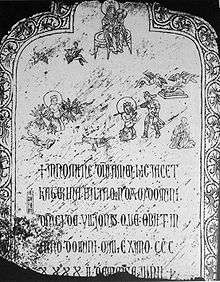Katarina Vilioni

Katarina Vilioni was an Italian woman who was a member of a trader family in Yangzhou, China, during the 14th century. She is known through a tombstone which was discovered among the ramparts of Yangzhou in 1951 by the People's Liberation Army. The tombstone is inscribed in Lombardic capitals, and explains that she died in 1342, and was the daughter of Domenico Vilioni. The tombstone also contains depictions of the martyrdom of Saint Catherine of Alexandria.
The existence of this tombstone in Yangzhou, a few decades after the visit of Marco Polo, who had some administrative role in the city, suggests that there was a thriving Italian community in the city, probably involved in silk trade.[1]
The tombstone reads:
- In nomine D[omi]ni amen hic jacet
- Katerina filia q[u]ondam Domini
- D[omi]nici de Vilionis que obiit in
- anno Domini mileximo[2] CCC
- XXXX II de mense Junii
"In the name of the Lord, amen. Here lies Caterina daughter of the deceased lord Domenico de Vilioni, who died in A.D. 1342, in the month of June."
The Medieval scholar Robert Lopez has corrected the reading of the family name to "Ilioni", and related the father to a certain "Dominico Ilioni", who was inscribed in 1348 in the registers of the city of Genoa in relation to a merchant named Jacopo de Oliverio, who is said by that document to have lived in the "Kingdom of Cathay", where he multiplied his capital fivefold.[3]
Another smaller plaque was discovered a few years later, together with a Christian sculpture and a short inscription mentioning the death of the son of the same Dominico, named Antonio, in November 1344.
This Italian community would have been supported by some form of religious structure. In 1322, the Franciscan Odoric de Pordenone visited Yangzhou, and said he resided among Franciscans there, and that there were also three Nestorian churches in the city.[4]
See also
Notes
- ↑ Frances Wood, p125-126
- ↑ Mileximo for millesimo
- ↑ "The Chan's Great Continent", Chap 1, Jonathan D.Spence here, also: "Les Mondes de Marco Polo", p.9
- ↑ "The Chan's Great Continent", Chap 1, Jonathan D.Spence here, also: "Les Mondes de Marco Polo", p.10
References
- "The Silk Road", Frances Wood, University of California Press, ISBN 0-520-24340-4
- "The Chan's Great Continent", Chap 1, Jonathan D. Spence, W. W. Norton & Company online
- Rouleau, Francis A.. 1954. “The yangchow Latin Tombstone as a Landmark of Medieval Christianity in China”. Harvard Journal of Asiatic Studies 17 (3/4). Harvard-Yenching Institute: 346–65. doi:10.2307/2718316. http://www.jstor.org/stable/2718316